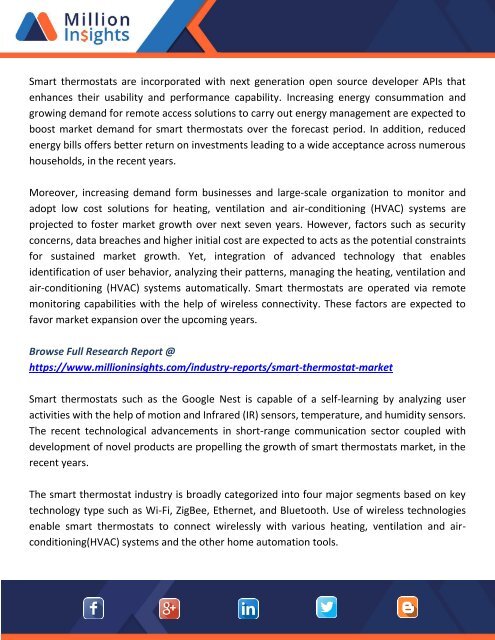Smart Thermostat Market Insights Sales, Cost, and Capacity Forecast To 2022
You also want an ePaper? Increase the reach of your titles
YUMPU automatically turns print PDFs into web optimized ePapers that Google loves.
<strong>Smart</strong> thermostats are incorporated with next generation open source developer APIs that<br />
enhances their usability <strong>and</strong> performance capability. Increasing energy consummation <strong>and</strong><br />
growing dem<strong>and</strong> for remote access solutions to carry out energy management are expected to<br />
boost market dem<strong>and</strong> for smart thermostats over the forecast period. In addition, reduced<br />
energy bills offers better return on investments leading to a wide acceptance across numerous<br />
households, in the recent years.<br />
Moreover, increasing dem<strong>and</strong> form businesses <strong>and</strong> large-scale organization to monitor <strong>and</strong><br />
adopt low cost solutions for heating, ventilation <strong>and</strong> air-conditioning (HVAC) systems are<br />
projected to foster market growth over next seven years. However, factors such as security<br />
concerns, data breaches <strong>and</strong> higher initial cost are expected to acts as the potential constraints<br />
for sustained market growth. Yet, integration of advanced technology that enables<br />
identification of user behavior, analyzing their patterns, managing the heating, ventilation <strong>and</strong><br />
air-conditioning (HVAC) systems automatically. <strong>Smart</strong> thermostats are operated via remote<br />
monitoring capabilities with the help of wireless connectivity. These factors are expected to<br />
favor market expansion over the upcoming years.<br />
Browse Full Research Report @<br />
https://www.millioninsights.com/industry-reports/smart-thermostat-market<br />
<strong>Smart</strong> thermostats such as the Google Nest is capable of a self-learning by analyzing user<br />
activities with the help of motion <strong>and</strong> Infrared (IR) sensors, temperature, <strong>and</strong> humidity sensors.<br />
The recent technological advancements in short-range communication sector coupled with<br />
development of novel products are propelling the growth of smart thermostats market, in the<br />
recent years.<br />
The smart thermostat industry is broadly categorized into four major segments based on key<br />
technology type such as Wi-Fi, ZigBee, Ethernet, <strong>and</strong> Bluetooth. Use of wireless technologies<br />
enable smart thermostats to connect wirelessly with various heating, ventilation <strong>and</strong> airconditioning(HVAC)<br />
systems <strong>and</strong> the other home automation tools.


















